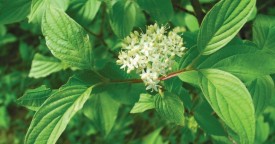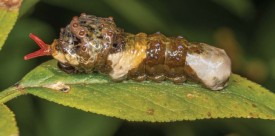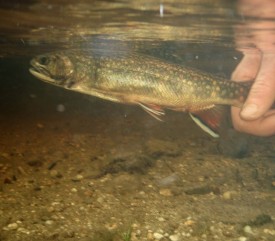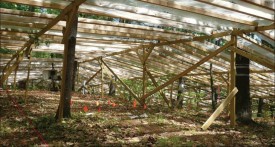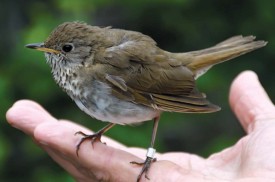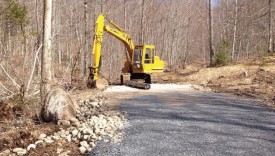Wolastoqiyik (Maliseet) and Mi’kmaq peoples maintain relationships with hundreds of species of plants and fungi in their forested homelands of the Canadian Maritimes, the Gaspe…
Discoveries
An Uncertain Future for Old Field Forests
When northeastern farmers left for the city or for greener pastures to the west in the early 20th century, their abandoned fields grew into sunlit forests marked by mossy stone walls, wolf…
Northern Shift of Our Largest Butterfly
The largest butterfly in North America has expanded its range from the South and Midwest during the last decade and is now appearing in much of New England with regularity. The eastern giant…
High Carbs in Trees Influence Response to Insect Outbreak
When thousands of acres of oak trees across southern New England died following an outbreak of spongy moth, (Lymantria dispar, formerly known as Gypsy moth), from 2016 to 2018, a team of…
Forest Density a Growing Concern
The number and size of trees that can occupy a given area has been a key metric in forest management for decades. It’s vital to ensuring the health of forests and the effectiveness of…
Vermont Brook Trout Numbers a Bright Spot in Region
Brook trout are among the most attractive freshwater fish in the Northeast and a favorite target of anglers in the region. Vermont state fisheries biologist Jud Kratzer said they look…
Lessons on Loon Breeding Success from the North
Common loons in the Northeast and nearby southern Canada have faced numerous environmental changes that have impacted their health in recent decades, from acid rain and mercury to the changing…
Invasive Earthworms Rediscovered in Northern Maine Forests
University of Maine researchers recently discovered invasive earthworms from Europe in Aroostook County, Maine timberlands, in what they say is the first reported sighting of the creatures in…
Climate Change and Red Oak Expansion
Many scientists have predicted that as the climate warms, red oak trees will gain a significant amount of suitable habitat in the Northeast and perhaps become a dominant species in northern…
Mercury Cycling in Northeastern Forests
Researchers studying mercury gas in the atmosphere have concluded that trees and plants absorb a vast amount of the toxic element in the same way that plants absorb carbon dioxide. Rainfall is…
Forest Management Implications for Ticks
With the risk of tick-borne diseases increasing in northern New England, scientists at the University of Maine launched a citizen science project in nine southern and coastal counties in 2020…
Ants Shift with Forests in a Changing Climate
Ants play a vital role in the health of forested ecosystems as seed dispersers, decomposers of wood and leaves, aerators of soil via their nesting and tunneling, recyclers of nutrients, and…
Influence of Drought on White Pine and Red Oak Growth
The drought that most of New England experienced last summer and fall is likely to slow the growth of white pines and red oaks this year. That’s the prediction from a University of New…
Dragonfly Larvae as Indicators of Environmental Health
Dragonfly larvae have long been considered an indicator of good water quality because many species require clear, clean water to thrive. Finding any of those species in a water body suggests…
Sustainable Fiddlehead Harvesting
The traditional springtime harvest of fiddleheads – the furled fronds of the ostrich fern – may be in jeopardy in areas where too many are plucked from the same plants in a season.…
Beech Trees Under Attack
Scientists are tracking a newly identified disease that kills American beech trees, and it is now spreading in southern New England and moving north. A microscopic worm called a nematode that…
Mercury Persists in Alpine Thrushes
When Chris Rimmer learned that mercury deposition from the atmosphere was two- to five-times greater at high elevations than at surrounding low elevations, it inspired him to examine whether…
A Century of Winter Climate Change
Most of the popular discussion about the changing climate focuses on summer conditions including the increased potential for drought and extreme heat, yet winter conditions are changing most…
Climate Stress Creating Shorter and Younger Forests
The changing climate is transforming forests around the world, and a new study has found that these changes are resulting in forests of shorter and younger trees. A review of 160 previous…
Corridors Improve Odds for Martens
Efforts to restore populations of the rare American marten after their disappearance from much of northern New England in the mid-1900s have had limited success. Despite several reintroduction…


